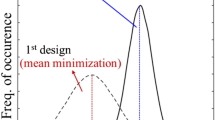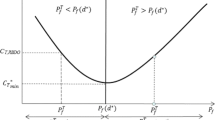Abstract
Robust design optimization (RDO) is a popular framework for addressing uncertainties in the design of engineering systems by considering different statistical measures, typically the mean and standard deviation of the system response. RDO can lead to a wide range of different candidate designs, establishing a different compromise between these competing objectives. This work introduces a new robustness measure, termed probability of dominance, for assessing the appropriateness of each candidate design. This measure is defined as the likelihood that a particular design will outperform the rival designs within a candidate set. Furthermore, a multi-stage implementation is introduced to facilitate increased versatility/confidence in the decision-making process by considering the comparison among smaller subsets within the initial larger set of candidate designs. For enhancing the robustness in these comparisons the impact of prediction errors, introduced to address potential differences between the real (i.e. as built) system and the numerical model adopted for it, is also addressed. This extends to proper modeling of the influence of the prediction error, including selection of its probability model, as well as evaluation of its impact on the probability of dominance and on the RDO formulation itself. Two illustrative examples are presented, the first considering the design of a tuned mass damper (TMD) for vibration mitigation of harmonic excitations and the second a topology optimization problem for minimum compliance. Extensive comparisons are presented in these two examples and the discussions demonstrate the power of the proposed approach for assessing the designs’ robustness.







Similar content being viewed by others
Abbreviations
- γ :
-
Parameter associated with definition of prediction error variance
- Δ:
-
Set of candidate designs
- ε :
-
Log of error when it is incorporated through a multiplicative formulation
- Θ:
-
Uncertain Space
- θ :
-
uncertain model parameters
- {θ j}:
-
Set of samples from p(θ)
- λ :
-
Decay rate for exponential correlation function
- μ(x):
-
Mean for system model
- μ s (x):
-
Mean for real system
- [μ o σ ο ]:
-
Utopia point (minimum mean and standard deviation) for system model
- [μ s σ s ]:
-
Utopia point (minimum mean and standard deviation) for real system
- v l :
-
Weight for defining norm for exponential correlation
- ρ ik :
-
Correlation function for the prediction errors associated with designs x i and x k
- Σ d il :
-
Covariance matrix for the vector composed of the error for i th design subtracting the errors from each of the designs in S d il
- σ(x):
-
Standard deviation for system model
- σ e :
-
Standard deviation for prediction error
- σ s (x):
-
Standard deviation for real system
- d :
-
Dimension of subsets of Δ under consideration
- D d (x i ):
-
Degree of dominance of design x i against the d-dimensional subsets
- D t :
-
Threshold for acceptable dominance level
- Dh d il (θ):
-
Vector of the different between performance for i th design and the performance of the designs in S d il
- Dl d il (θ):
-
Version of Dh d il (θ) utilizing log of performance
- Ε[.]:
-
Expectation for random variable
- e :
-
Prediction error
- F G [.]:
-
Gaussian cumulative distribution function
- f(x):
-
Objective function
- h(x, θ):
-
Performance function for system model
- h s (x):
-
Performance function for real model
- I(A i , θ):
-
Indicator function for dominance of x i against set A for given θ
- . i :
-
Subscript i. Characteristic associated with the i th design
- M d il :
-
Margin of dominance for design x i within set S d il
- m :
-
Number of designs in Δ
- N :
-
Number of samples for stochastic simulation
- n θ :
-
Dimension of θ
- n x :
-
Dimension of x
- P D (x i |A):
-
Probability of dominance of design x i over set A
- P D (x i |A,θ):
-
Probability of dominance of design x i over set A given the system configuration θ
- \( {\tilde{P}}_D\left({\mathbf{x}}_i\Big|A\right) \) :
-
Probability of dominance of design x i over set A calculated through Monte Carlo simulation
- p(θ):
-
Probability density function for θ
- p(e):
-
Probability model for prediction error
- S d :
-
Set of all possible d-dimensional subsets of Δ
- S d i :
-
Set of d-dimensional subsets of Δ including design x i
- S d il :
-
l th subset of d-dimensional subsets of Δ including design x i
- w :
-
Weight used in the RDO formulation
- X :
-
Admissible design space
- \( \underset{\bar{\mkern6mu}}{\mathbf{x}} \) :
-
Ordered of candidate designs based on probability of dominance P D (x i |Δ)
- x :
-
Design variable vector
- x dli k :
-
k th design within the S d il set
References
Beck JL (2010) Bayesian system identification based on probability logic. Struct Control Health Monit 17(7):825–847
Beck AT, Santana Gomes WJ (2012) A comparison of deterministic, reliability-based and risk-based structural optimization under uncertainty. Probabilistic Eng Mech 12:18–29
Beck JL, Taflanidis A (2013) Prior and posterior robust stochastic predictions for dynamical systems using probability logic. J Uncertain Quantif 3(4):271–288
Bendsøe MP, Sigmund O (2003) Topology optimization: theory, methods, and applications. Springer Verlag, Berlin, Germany
Beyer H-G, Sendhoff B (2007) Robust optimization - a comprehensive survey. Comput Methods Appl Mech Eng 196:3190–3218
Chang CC (1999) Mass dampers and their optimal designs for building vibration control. Eng Struct 21:454–463
Chen S, Chen W, Lee S (2010) Level set based robust shape and topology optimization under random field uncertainties. Struct Multidiscip Optim 41(4):506–534
Debbarma R, Chakraborty S, Kumar Ghosh S (2010) Optimum design of tuned liquid column dampers under stochastic earthquake load considering uncertain bounded system parameters. Int J Mech Sci 52(10):1385–1393
Doltsinis I (2004) Robust design of structures using optimization methods. Comput Methods Appl Mech Eng 193(23–26):2221–2237
Dunning PD, Kim HA (2013) Robust topology optimization: minimization of expected and variance of compliance. AIAA J 51(11):2656–2664
Dunning PD, Kim HA, Mullineux G (2011) Introducing loading uncertainty in topology optimization. AIAA J 49(4):760–768
Genz A (1992) Numerical computation of multivariate normal probabilities. J Comput Graph Stat 1(2):141–149
Jaynes ET (2003) Probability theory: the logic of science. Cambridge University Press, Cambridge, UK
Johnson RA, Wichern DW (2002) Applied multivariate statistical analysis, 5th edn. Hall Prentice, Upper Saddle River
Kalyanmoy D, Gupta H (2006) Introducing robustness in multi-objective optimization. Evol Comput 14(4):463–494
Karrem A, Kline S (1993) Performance of multiple mass dampers under random loading. J Struct Eng ASCE 121(2):348–361
Keeney RL, Raiffa H (1993) Decisions with multiple objectives: preferences and trade-offs. Press Cambridge University, Cambridge
Kwon S-D, Park K-S (2004) Suppression of bridge flutter using tuned mass dampers based on robust performance design. J Wind Eng Ind Aerodyn 92(11):919–934
Law AM, Kelton WD (2000) Simulation modeling and analysis, 3rd edn. Mc.Graw Hill, Boston, MA
Lee K-H, Park G-J (2001) Robust optimization considering tolerances of design variables. Comput Struct 79(1):77–86
Lophaven SN, Nielsen HB, Sondergaard J (2002) Aspects of the MATLAB toolbox DACE. Informatics and mathematical modelling report IMM-REP-2002-13. Technical University of Denmark
Marano GC, Sgobba S, Greco R, Mezzina M (2008) Robust optimum design of tuned mass dampers devices in random vibrations mitigation. J Sound Vib 313(3–5):472–492
Marler RT, Arora JS (2004) Survey of multi-objective optimization methods for engineering. Struct Multidiscip Optim 26:369–395
Miettinen K (1999) Nonlinear multiobjective optimization. Kluwer Academic Publishers, Dordrecht
Mohtat A, Dehghan-Niri E (2011) Generalized framework for robust design of tuned mass damper systems. J Sound Vib 330(5):902–922
Papadimitriou C, Lombaert G (2012) The effect of prediction error correlation on optimal sensor placement in structural dynamics. Mech Syst Signal Process 28:105–127
Porter KA, Kennedy RP, Bachman RE (2007) Creating fragility functions for performance-based earthquake engineering. Earthquake Spectra 23(2):471–489
Rangavajhala S (2007) Decision making in design under uncertainty with multiobjective robust design optimization. Renssealer Polytechnic Institute, Troy, NY
Reeves GR, Gonzalez JJ (1989) A comparison of two interactive MCDM procedures. Eur J Oper Res 41:203–209
Rietz A (2001) Sufficiency of a finite exponent in SIMP (power law) methods. Struct Multidiscip Optim 21(2):159–163
Robert CP, Casella G (2004) Monte Carlo statistical methods, 2nd edn. Springer, New York, NY
Sawaragi Y, Nakamura H, Tanino T (1985) Theory of multiobjective optimization. Academic Press New York, NY
Schuëller GI, Jensen HA (2008) Computational methods in optimization considering uncertainties - an overview. Comput Methods Appl Mech Eng 198(1):2–13
Sigmund O (2001) 99 line topology optimization code written in Matlab. Struct Multidiscip Optim 21(2):120–127
Spall JC (2003) Introduction to stochastic search and optimization. Wiley-Interscience, New York
Svanberg K (1987) The method of moving asymptotes - a new method for structural optimization. Int J Numer Methods Eng 24(2):359–373
Taflanidis AA, Beck JL (2010) Reliability-based design using two-stage stochastic optimization with a treatment of model prediction errors. J Eng Mech 136(12):1460–1473
Taflanidis AA, Vetter C, Loukogeorgaki E (2013) Impact of modeling and excitation uncertainties on operational and structural reliability of tension leg platforms. Appl Ocean Res 43:131–147
Tootkaboni M, Asadpoure A, Guest JK (2012) Topology optimization of continuum structures under uncertainty-a polynomial chaos approach. Comput Methods Appl Mech Eng 201–204:263–275
Weber M (1987) Decision making with incomplete information. Eur J Oper Res 28(1):44–57
Zang C, Friswell MI, Mottershead JE (2005) A review of robust optimal design and its application in dynamics. Comput Struct 83(3–5):315–326
Author information
Authors and Affiliations
Corresponding author
Rights and permissions
About this article
Cite this article
Medina, J.C., Taflanidis, A. Probabilistic measures for assessing appropriateness of robust design optimization solutions. Struct Multidisc Optim 51, 813–834 (2015). https://doi.org/10.1007/s00158-014-1160-5
Received:
Revised:
Accepted:
Published:
Issue Date:
DOI: https://doi.org/10.1007/s00158-014-1160-5




